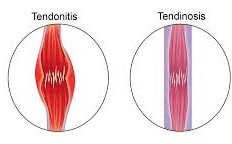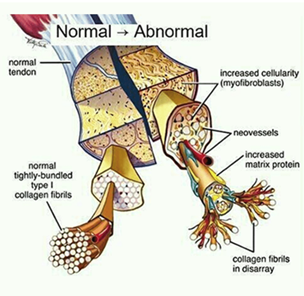Tendons are the tissues that are between the bone and muscle. They are white in colour and their fibrous/elastic composition gives them great strength that allows the transmission of large mechanical forces. The purpose of the tendon, when it is fully functioning is to elicit movement from the contraction of the muscle onto the bone. However, a tendon is not always fully functioning, especially if you are moving incorrectly causing incorrect forces acting on the tendon or have previously injured the tendon. These will result in pain and dysfunction in the tendon, known as tendinopathy.
Tendinopathy/Tendonitis/Tendonosis are all terms that you may have heard used by medical professionals that mean that you have a damaged tendon.

Tendinopathy is an umbrella term for something wrong with the tendon.
Tendonitis, due to the ITIS at the end of the word, meaning there is some inflammatory component to the tendon. This is commonly the tissue that surrounds the tendon called the paratenon. Much research has been done and has shown the tendon itself does not actually get inflamed.
The term tendonosis with the OSIS at the end, meaning there are some degenerative changes occurring within the tendon. We can see this on an ultrasound scan where the fibers are not all lined up linearly as we would expect and in some cases, some new blood vessels are growing into the tendon. This is call neovascularisation.
Due to this research and correct labeling of tendon injuries now we are much more specific with the type of exercises we give to help with recovery.
The treatment of tendinopathy will depend on the intensity, irritability, and severity of the pain as well as how acute the injury is, the area of injury on the body and the tendon, the individual’s medical and injury history, biomechanics, and function. All of this is vital to the rehabilitation of such an injury; therefore, it is always important to consult a Physiotherapist after sustaining a tendon injury.
Tendinopathies present fairly similarly and the four most important pieces of advice would be:
1. Expect some increase in pain during/after exercise
2. Normally a maximum of 3/10 level of pain is acceptable and has actually been shown to be beneficial when doing your exercises.
3. Symptoms should settle back to baseline relatively quickly so if you are worse that evening or the next day then the load you have given your tendon during your exercise might have been a bit too much.
4. It can take up to 12 weeks before any significant change in symptoms, so be patient.
Typically, with rehabilitation for tendinopathies, we would look to progress you from beginner, isometric exercises, where you hold the position with some load for 10 seconds 3 times, onto intermediate, isotonic loading, which moves the loaded tendon through the range in a controlled way, right through to the high level, energy storage exercises. Here you need to do some springing and rebounding work to start mimicking what the tendon actually does in functional, daily activities. Where you are in these stages will all be relative to the variables mentioned above.
One important part of your rehabilitation plan is that you mustn’t stop loading your tendon. Complete rest has been shown to be detrimental and slow the rehabilitation process. We encourage you to do as much as you can whilst not aggravating it further. For example, if you have an Achilles tendon injury, which is aggravated when you run, we encourage you to go out and keep up with your walking. If you have a shoulder tendon injury and you are unable to do activities over your head, we encourage you to keep doing as many activities below shoulder height that still puts a load on the tendons in your shoulder but not aggravate them.
Tendon injuries (like Achilles Tendon Pain, tennis elbow, golfer’s elbow, carpal tunnel syndrome) now have a lot clearer rehabilitation pathways to enable full recovery as much more research has been done in recent years. Once you have worked out where you can start your loading programme from, then gradually increase the load and intensity over time always ensuring correct technique and loading biomechanics. If you would like us to take a look and start you off on this process, just let us know.

